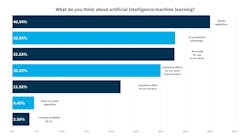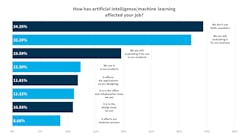Understanding the role of AI/ML in photonics and electronic design
For all the talk about artificial intelligence (AI) and machine learning (ML) in the general press, you’d think anyone who designs anything uses it in their business or incorporates it into their new applications and products. After all, engineers, with their days spent using and creating the latest innovations, could be expected to lead the way.
However, a recent survey of the Laser Focus World (LFW) and six sister brand audiences indicates opinions and uptake of the leading-edge technologies range more widely than you might expect. LFW is part of Endeavor Business Media’s Design & Engineering group of media brands, which includes Electronic Design (ED), Machine Design (MD), Microwaves & RF (MWRF), Power & Motion (PMT), Military+Aerospace Electronics (MAE), and Vision Systems Design (VSD).
The combined audience of the approximately 1000 designers who responded offers a look into where AI/ML has made inroads into the work processes, products, and tools engineers design and use. The total number of respondents varied from question to question, as some skipped answering some questions.
First, in response to a question asking what they thought about AI/ML, the top choice across nearly all brands is "AI/ML needs to be regulated," including 40.3% of LFW respondents. Only VSD had more respondents (42.6%) choose another answer most often: "AI/ML has had a positive effect on our tools and processes.” Still, 36.9% of VSD respondents agreed that AI/ML needs to be regulated.
Indeed, by significant margins, VSD had the most respondents who said AI/ML positively affected their tools and processes (42.6%) and products (35.3%). Just over 26% of LFW respondents expressed similar sentiments, ranking sixth of the seven properties regarding tools and processes and second regarding products.
Taken together, a significantly higher percentage of all respondents indicated a positive effect on their tools and processes (32.9%) than on their products (24.2%). Respondents were encouraged to choose all that apply.
Interestingly, when asked which technologies significantly impact their designs, AI/ML ranked a close fourth for LFW respondents, with 29.2% choosing it. The top three choices were test equipment (34%), software reliability (31.2%), and sensor integration (29.6%). The other audiences combined ranked AI/ML seventh, with 21.6% selecting it. However, VSD respondents comprised 46.9% of this group, skewing the overall ranking.
That said, healthy percentages of respondents, from nearly 30% to over 35%, across the brands indicate they think AI/ML is a competitive advantage, with LFW respondents (35.8%) topping the list.
Perhaps most surprisingly, when asked how AI/ML has affected their jobs, a significant percentage of respondents on all but two brands, VSD (16.1%) and MAE (29.1%), say they don't use the technologies anywhere in their company. These include MD (43.1%), PMT (39%), ED (38.5%), MWRF (38.4%), and LFW (30.1%). Additionally, significant percentages of respondents across all brands, ranging from VSD’s 27.1% to LFW’s 32.1% to MD’s 41.1%, say AI/ML “is not ready for use in our space.”
Still, AI/ML currently impacts various elements of designers' work, including the applications they design (11.85), business processes (8.6%), office and collaboration tools (11.1%), and design tools (10.9%). Moreover, over 12.3% are using AI/ML in their products, and a majority (51.8%) say they are evaluating AI/ML for use in their business (32.2%) and products (19.6%).
Whether you view AI/ML as overwrought or legit, this data confirms AI/ML will be a part of every designer's future—and the audiences of the Endeavor Business Media Design & Engineering Group brands are judiciously leading the way.

Patricia Panchak
Patricia Panchak has held editorial leadership roles for over 25 years—15 years of which were with IndustryWeek as the brand’s managing editor and then editor-in-chief. From 2011 through 2017, she then served as group content director for the Manufacturing & Supply Chain Group, which included IndustryWeek.
Since 2018, Patricia spent time as a business journalist, editorial consultant, and public speaker, specializing in business and manufacturing strategies and best practices; trends and emerging technologies; and public policy.


